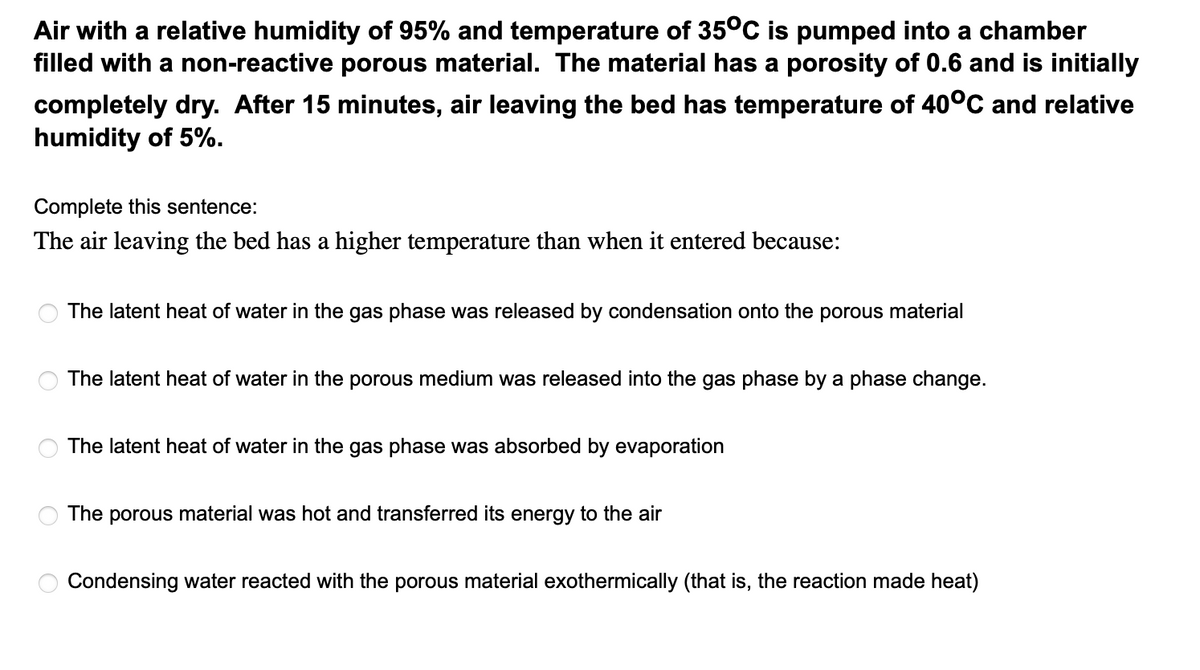Air with a relative humidity of 95% and temperature of 35°C is pumped into a chamber filled with a non-reactive porous material. The material has a porosity of 0.6 and is initially completely dry. After 15 minutes, air leaving the bed has temperature of 40°C and relative humidity of 5%.
Air with a relative humidity of 95% and temperature of 35°C is pumped into a chamber filled with a non-reactive porous material. The material has a porosity of 0.6 and is initially completely dry. After 15 minutes, air leaving the bed has temperature of 40°C and relative humidity of 5%.
Chemistry
10th Edition
ISBN:9781305957404
Author:Steven S. Zumdahl, Susan A. Zumdahl, Donald J. DeCoste
Publisher:Steven S. Zumdahl, Susan A. Zumdahl, Donald J. DeCoste
Chapter1: Chemical Foundations
Section: Chapter Questions
Problem 1RQ: Define and explain the differences between the following terms. a. law and theory b. theory and...
Related questions
Question

Transcribed Image Text:Air with a relative humidity of 95% and temperature of 35°C is pumped into a chamber
filled with a non-reactive porous material. The material has a porosity of 0.6 and is initially
completely dry. After 15 minutes, air leaving the bed has temperature of 40°C and relative
humidity of 5%.
Complete this sentence:
The air leaving the bed has a higher temperature than when it entered because:
The latent heat of water in the gas phase was released by condensation onto the porous material
The latent heat of water in the porous medium was released into the gas phase by a phase change.
The latent heat of water in the gas phase was absorbed by evaporation
The porous material was hot and transferred its energy to the air
O Condensing water reacted with the porous material exothermically (that is, the reaction made heat)
Expert Solution
This question has been solved!
Explore an expertly crafted, step-by-step solution for a thorough understanding of key concepts.
Step by step
Solved in 2 steps

Knowledge Booster
Learn more about
Need a deep-dive on the concept behind this application? Look no further. Learn more about this topic, chemistry and related others by exploring similar questions and additional content below.Recommended textbooks for you

Chemistry
Chemistry
ISBN:
9781305957404
Author:
Steven S. Zumdahl, Susan A. Zumdahl, Donald J. DeCoste
Publisher:
Cengage Learning

Chemistry
Chemistry
ISBN:
9781259911156
Author:
Raymond Chang Dr., Jason Overby Professor
Publisher:
McGraw-Hill Education

Principles of Instrumental Analysis
Chemistry
ISBN:
9781305577213
Author:
Douglas A. Skoog, F. James Holler, Stanley R. Crouch
Publisher:
Cengage Learning

Chemistry
Chemistry
ISBN:
9781305957404
Author:
Steven S. Zumdahl, Susan A. Zumdahl, Donald J. DeCoste
Publisher:
Cengage Learning

Chemistry
Chemistry
ISBN:
9781259911156
Author:
Raymond Chang Dr., Jason Overby Professor
Publisher:
McGraw-Hill Education

Principles of Instrumental Analysis
Chemistry
ISBN:
9781305577213
Author:
Douglas A. Skoog, F. James Holler, Stanley R. Crouch
Publisher:
Cengage Learning

Organic Chemistry
Chemistry
ISBN:
9780078021558
Author:
Janice Gorzynski Smith Dr.
Publisher:
McGraw-Hill Education

Chemistry: Principles and Reactions
Chemistry
ISBN:
9781305079373
Author:
William L. Masterton, Cecile N. Hurley
Publisher:
Cengage Learning

Elementary Principles of Chemical Processes, Bind…
Chemistry
ISBN:
9781118431221
Author:
Richard M. Felder, Ronald W. Rousseau, Lisa G. Bullard
Publisher:
WILEY